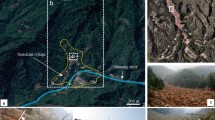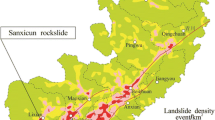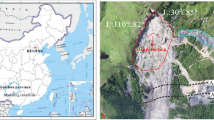Abstract
After the first high-position landslide occurred in Baige Village, a second slide originated from the crown of the first landslide on November 3. The approximately 1.6 million m3 second slide moved rapidly and applied an impact load on the upper part of the residual mass of the first landslide, resulting in a 6.6 million m3 entrainment volume. The sliding mass rushed into the Jinsha River and blocked the channel again, causing catastrophic flooding which destroyed numerous roadbeds, bridges, and a large number of residential houses in Sichuan and Yunnan provinces. Based on field investigations and simulation results by dynamic discrete element method (DEM), after the first landslide, the blocks formed by the trailing edge of the landslide became unstable and slid, continuously and dynamically loading and accumulating on the upper part of the first debris deposit, which rested in the grooved terrain of the slope, leading to the instability of the residual slope’s rock–soil mass and the initiation of a debris avalanche. With a peak velocity of 62 m/s, the debris avalanche slid rapidly to the location of the first slide deposit. Due to the topographic effect, it was transformed into a diffused debris avalanche, which scattered and accumulated, exhibiting the typical characteristics of a rapid long-runout landslide. Then, the calculated velocity value by DEM was also compared with those using other dynamic modeling approaches (e.g., sled model and rheological model). The DEM was proven producing a reasonable velocity variation pattern, and thus, it is suitable for the simulation of the entire movement process of high-position rockslides similar to the second Baige landslide.















Similar content being viewed by others
References
Cagnoli B, Piersanti A (2017) Combined effects of grain size, flow volume and channel width on geophysical flow mobility: three-dimensional discrete element modeling of dry and dense flows of angular rock fragments. Solid Earth 8:177–188
Chen DN, Sarumi M, Al-Hassani STS (1998) Computational mean particle erosion model. Wear 214:64–73
Cundall PA, Strack O (1979) A discrete numerical model for granular assemblies. Geotechnique 29:47–65
Davies T, McSaveney MJ (1999) Runout of dry granular avalanches. Can Geotech J 36:313–320
Deng JH, Gao YJ, Yu ZQ, Xie HP (2019) Analysis on the formation mechanism and process of baige Landslides damming the upper reach of Jinsha River,China. Adv Eng Sci 51(1):9–16 (in Chinese)
EDEM (2018) Website, https://www.edemsimulation.com/
Fan XM, Xu Q, Scaringi G, Dai LX, Li, Dong XJ, Zhu X, Pei XJ, Dai KR, Havenith HB (2018) Failure mechanism and kinematics of the deadly June 24th 2017 Xinmo landslide, Maoxian, Sichuan, China. Landslides 14(9):2129–2146
Fan XM, Xu Q, Alonso-Rodriguez A, Subramanian S, Li WL, Zheng G, Dong XJ, Huang RQ (2019) Successive landsliding and damming of the Jinsha River in eastern Tibet, China: prime investigation, early warning, and emergency response. Landslides 16(5):1003–1020
Feng ZY, Lo CM, Lin QF (2017) The characteristics of the seismic signals induced by landslides using a coupling of discrete element and finite difference methods. Landslides 14(2):661–674
Hungr O (1995) A model for the run out analysis of rapid flow slides, debris flows, and avalanches. Can Geotech J 32:610–623
Hungr O, McDougall S (2009) Two numerical models for rockslide dynamic analysis. Comput Geosci 35:978–992
Kang C, Chan D (2018) Numerical simulation of 2D granular flow entrainment using DEM. Granul Matter 20(13):1–17
McDougall S, Hungr O (2005) Dynamic modelling of entrainment in rapid landslides. Can Geotech J 42(5):1437–1448
McSaveney MJ, Davies TR (2007) Rockslides and their motion, Chapter 8. In: Sassa K, Fukuoka H, Wang F, Wang G (eds) Progress in landslide science. Springer, Heidelberg, pp 113–133
Ouyang CJ, An HC, Zhou S, Wang ZW, Su PC, Wang DP, Cheng DX, She JX (2019) Insights from the failure and dynamic characteristics of two sequential landslides at Baige village along the Jinsha River, China. Landslides 16(7):1397–1414
Pirulli M, Pastor M (2012) Numerical study on the entrainment of bed material into rapid landslides. Geotechnique 62(11):959–972
Sassa K, Nagai O, Solidum R et al (2010) An integrated model simulating the initiation and motion of earthquake and rain induced rapid landslides and its application to the 2006 Leyte landslide. Landslides 7(3):219–236
Sassa K, He B, Dang K, Nagai O, Takara K (2014) Plenary: progress in landslide dynamics. In: Sassa K, Canuti P, Yin YP (eds) Landslide science for a safer geoenvironment. Springer International Publishing, Switzerland, pp 37–67
Scheidegger AE (1973) On the prediction of the reach and velocity of catastrophic landslides. Rock Mech Rock Eng 5(4):231–236
Tsuji Y, Tanaka T, Ishida T (1992) Lagrangian numerical simulation of plug flow of cohesionless particles in a horizontal pipe. Powder Technol 71:239–250
Wang LC, Wen MS, Feng Z, Sun WF, Wei YJ, Li JF, Wang WP (2019a) Researches on the Baige landslide at Jinshajiang River, Tibet, China. The Chinese Journal of Geological Hazard and Control 30(1):1–9 (in Chinese)
Wang WP, Yin YP, Yang LW et al (2019b) Investigation and dynamic analysis of the catastrophic rockslide avalanche at Xinmo, Maoxian, after the Wenchuan Ms 8.0 earthquake. Bull Eng Geol Environ. https://doi.org/10.1007/s10064-019-01557-4
Xing AG, Wang GH, Li B et al (2014) Long-runout mechanism and landsliding behaviour of large catastrophic landslide triggered by heavy rainfall in Guanling, Guizhou,China. Can Geotech J 52(7):971–981
Xu Q, Zheng G, Li WL, He CY, Dong XJ, Guo C, Feng WK (2018) Study on successive landslide damming events of Jinsha River in Baige Village on Octorber 11 and November 3, 2018. J Eng Geol 26(6):1534–1551 (in Chinese)
Yin YP, Cheng YL, Liang JT, Wang WP (2016) Heavy-rainfall-induced catastrophic rockslide debris flow at Sanxicun, Dujiangyan, after the Wenchuan Ms 8.0 earthquake. Landslides 13(1):9–23
Yin YP, Wang WP, Zhang N, Yan JK, Wei YJ, Yang LW (2017) Long runout geological disaster initiated by the ridge-top rockslide in a strong earthquake area: A case study of the Xinmo landslide in Maoxian County, Sichuan Province. Geol China 44(5):827–841 (in Chinese)
Zhang M, McSaveney MJ (2017) Rock avalanche deposits store quantitative evidence on internal shear during runout. Geophys Res Lett 44(17):8814–8821
Acknowledgments
We are grateful to Geological Engineering Investigation Institute, MeiShan for supplying some field survey data. We are also grateful to Engineer Yiqiu Deng and Engineer Ming Gong from Hi-key Technology for their help in EDEM software operation. In addition, we are also grateful to the Editor in Chief of Bulletin of Engineering Geology and the Environment, Louis N.Y. Wong, for reconsidering the revised manuscript. Finally, the authors would like to thank the reviewers of this manuscript for their good suggestions and useful comments.
Funding
The study was financially supported by the National Key R&D Program of China (Grant No. 2018YFC1505404), National Natural Science Foundation of China (No. 41731287), and Geological Disaster Detailed Investigation Project of China Geological Survey (Grant No. DD20190637).
Author information
Authors and Affiliations
Corresponding author
Rights and permissions
About this article
Cite this article
Wang, W., Yin, Y., Zhu, S. et al. Investigation and numerical modeling of the overloading-induced catastrophic rockslide avalanche in Baige, Tibet, China. Bull Eng Geol Environ 79, 1765–1779 (2020). https://doi.org/10.1007/s10064-019-01664-2
Received:
Accepted:
Published:
Issue Date:
DOI: https://doi.org/10.1007/s10064-019-01664-2




